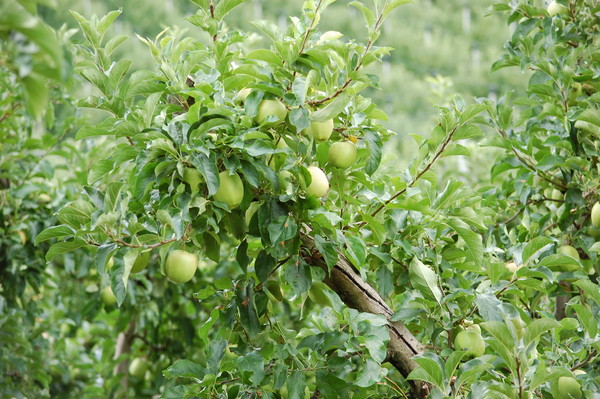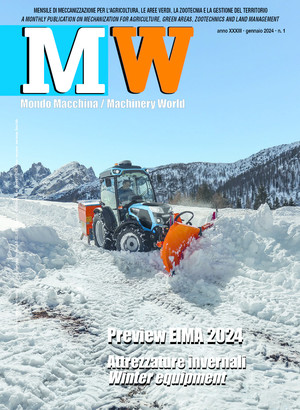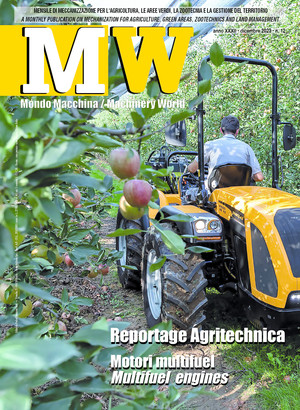
More sustainable fruit and vegetable industry thanks to green chemistry
Green chemistry can provide more effective and sustainable solutions to the many problems affecting the agricultural sector. A survey conducted by the CREA Policies and Bio-economy Research Center examined research institutions, operators and administrations, in order to identify innovative techniques and technologies with a low environmental impact and to protect the agrosystems involved in fruit and vegetable industry. By focusing on combined actions, green chemistry (as opposed to chemical syntheses) aims at preventing rather than treating and curing. In this context, mechanization plays a relevant role
In agriculture, as well as in other production sectors, research and innovation play a central role by contributing to the improvement of economic, environmental, and social sustainability. Innovation capacity is required to meet the constantly changing demands of the market and the delicate balance regulating the agroecosystems. Hence, it is important that all the subjects involved in the creation of new knowledge can dialogue with each other and share experiences and development paths. The contribution is as effective as it is inspired by the experience of businesses and technicians which are in contact with day-to-day operating activities. In this perspective, the Focus on innovation titled “Green chemistry”, one of the five initiatives promoted by the CREA – Policies and Bio-economy Research Center (CREA-PB) – takes place within the National Rural Network to identify high-sustainability solutions (with particular regard to the fruit and vegetable sector) to the problems emerged in connection with production and processing stages and ensure dissemination of information among interested parties.
The survey started from a workshop organized in March 2018 (“Opportunities and restrictions for a sustainable fruit and vegetable industry – The problems of the sector according to the stakeholders’ view”), in which Crea, Cnr, and Enea researchers participated together with Universities and large operators of the sector. From this first workshop, a document was published (“For a sustainable fruit and vegetable industry – Measures proposed by the Green chemistry”) and a dedicated Scientific Committee was established to examine a number of key issues according to the following steps: identify the sector’s problems (preliminary step); find the possible solutions within the context of bio-economy (identification step); test the conditions of application of these solutions in various contexts (validation step), and, finally spread the solutions identified to the interested parties (spreading step).
The investigation of problems concerning the Italian fruit and vegetable industry – conducted by the Bionet Green Chemistry Association in collaboration with Itabia – took place by involving the sector’s stakeholders (producers, technicians, researchers, and institutional representatives) through ongoing dialogue. The survey was conducted in the first instance through a questionnaire addressed to the main operators of the sector. Subsequently, to be more effective, direct meetings were organized with technicians, regional officials, businesses and operators in six Italian regions: Campania, Lazio, Marche, Puglia, Sicily, and Trentino Alto Adige. These meetings highlighted the main critical issues of the sector. A technical issue is represented by the spreading of new pathologies (see the Asian bug). Therefore, some bureaucratic and regulatory procedures hinder the implementation of alternative solutions that may be already applied, from the most simple one consisting in composting companies’ residues, to the most delicate solution concerning the use of allochthonous insects.
The possible solutions are well described in eight files downloadable from the Crea-Pb site (www.reterurale.it/FocusChimicaVerde). The innovative experiences emerged from the meetings and an analysis of solutions conducted by the Scientific Committee resulted in informative sheets which have no claim of completeness or consistency but aim at showing the potential of green chemistry in support of a more sustainable and effective agriculture, also thanks to a differently outlined approach to the problems.
The first topic considered is “Cropping system”, namely crop-sorting choices integrated with coherent solutions, so as to ensure a threefold result: 1) improvement of soil and soil characteristics through green manure crops, soil improvers and fertilizers obtained from residues such as compost, digestate and biochar; 2) weed control through mechanical processing operations, flameweeding, and biodegradable mulching sheets; 3) prevention and control of pathogens through alternative technical means, such as bio-pesticides and bio-fumigants, plant protection products, organic plant growth stimulators, micro-organisms, organic activators, and antagonistic insects. The other topics examined concern bio-based supports during cultivation, post-harvesting conservation methods, residue management, and packaging, as consumers demand the development of biodegradable and recyclable packaging solutions. It is evident that within the identified solutions, green chemistry products play a relevant but not exclusive role. It is necessary to clarify that, in this survey, for “green chemistry” it is intended a body of knowledge and techniques for the use of raw materials derived from living organisms: plants, animals, fungi, algae, bacteria, yeasts, and other micro-organisms, namely organic raw materials with a short carbon cycle (as opposed to those of fossil origin, such as oil, carbon, natural gas, etc.). Green chemistry is in fact different from petrochemical industry for several reasons. Firstly, it operates through more sustainable processes and products, thanks to the use of renewable raw materials that are easily biodegradable and generally scarcely toxic to man and the environment. Therefore, it has an extremely rich and complex combination of molecules than petrochemical products and requires the use of highly alternative knowledge and methodologies derived from genetics, molecular biology and life science in general.
Innovation through green chemistry demands, therefore, not only the introduction of new products but also a brand new approach: new products shall be used for preventive and polyvalent purposes. These products help plants develop their own defenses by supplying specific nutrients, improving soil with micro-organisms useful to fight pathogens or simply by enriching organic compounds and improving soil structure. Another basic concept included in green chemistry is represented by the circular economy. Moreover, considering that each biomass type has a high content of usable molecules, its residue can provide further environmental and economic benefits. For this reason, FederUnacoma supported the Crea-Pb Project in the start-up phase during EIMA International 2018 and is going to spread the final results during the next Agrilevante exhibition (Bari, 10-13 October 2019).








